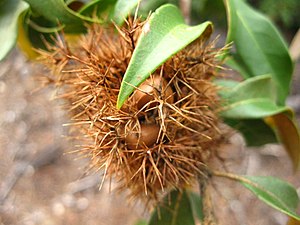Difference between revisions of "Chrysolepis"
Jump to navigation
Jump to search
m (1 revision: From PNW foraging book - part 1) |
(cut down) |
||
| Line 1: | Line 1: | ||
| − | |||
| − | |||
{{taxobox | {{taxobox | ||
|name = ''Chrysolepis'' | |name = ''Chrysolepis'' | ||
| Line 17: | Line 15: | ||
|}} | |}} | ||
| − | '''''Chrysolepis''''' is a small genus in the beech family [[Fagaceae]], [[endemic (ecology)|endemic]] to the western United States. Its two species have the common name '''chinquapin''' | + | '''''Chrysolepis''''' is a small genus in the beech family [[Fagaceae]], [[endemic (ecology)|endemic]] to the western United States. Its two species have the common name '''chinquapin'''. |
| − | + | {{Ack-Wikipedia}} | |
| − | |||
| − | |||
| − | |||
| − | |||
| − | |||
| − | |||
| − | |||
| − | |||
| − | |||
| − | |||
| − | |||
| − | |||
| − | |||
| − | |||
| − | |||
| − | |||
| − | |||
| − | |||
| − | |||
| − | |||
| − | |||
| − | |||
| − | |||
| − | |||
| − | |||
| − | |||
| − | |||
| − | |||
[[Category:Fagaceae]] | [[Category:Fagaceae]] | ||
| − | + | [[Category:Plants for Keenan to eat]] | |
| − | |||
| − | |||
| − | |||
| − | |||
| − | |||
| − | |||
| − | [[Category:Plants | ||
Latest revision as of 18:28, 20 August 2018
| Chrysolepis | |
|---|---|

| |
| Chrysolepis chrysophylla | |
| Scientific classification | |
| Kingdom: | |
| (unranked): | |
| (unranked): | |
| (unranked): | |
| Order: | |
| Family: | |
| Genus: | Chrysolepis
|
| Species | |
Chrysolepis is a small genus in the beech family Fagaceae, endemic to the western United States. Its two species have the common name chinquapin.
Acknowledgements
This article uses material from the Wikipedia article Chrysolepis, which is released under the Creative Commons Attribution-Share-Alike License 3.0.